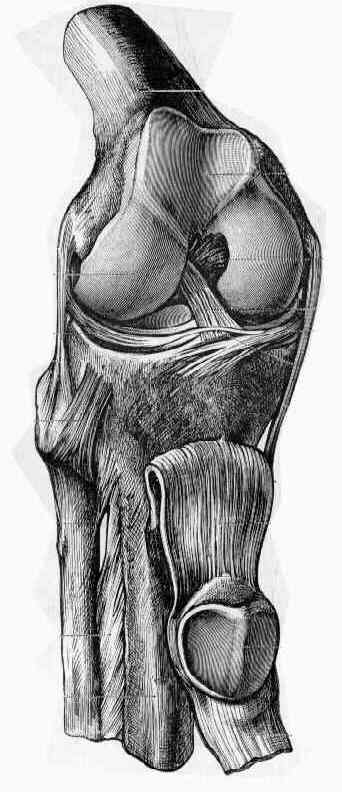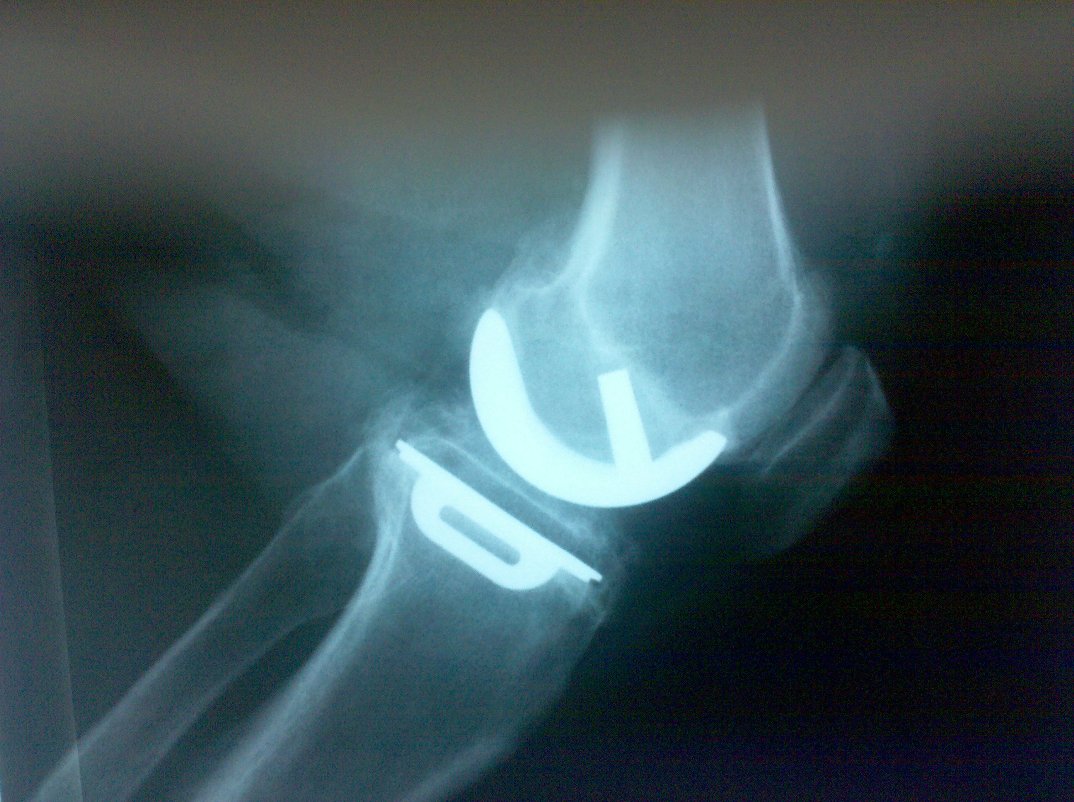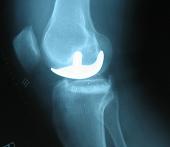- Discussion:
- unicompartmental arthroplasty serves a specific nitch for knees that are too severe for
arthroscopic management of medial DJD (see mosaicplasty) but are not severe enough
for total knee replacement;
- best indications:
- UKR for patients with partial thickness cartilage loss in the affected compartment.
- The implications of damage to the lateral femoral condyle on medial unicompartmental knee replacement.
- cautions: recent articles urge caution with this procedure and need to follow strict precautions;
- references:
- Early Failures in Unicondylar Arthroplasty
- Failure mechanisms after unicompartmental and tricompartmental primary knee replacement with cement.
- Reintervention after Mobile-bearing Oxford Unicompartmental Knee Arthroplasty
- Unicompartmental knee arthroplasty in patients aged less than 65.
- Preoperative lateral subluxation of the patella is a predictor of poor early outcome of Oxford phase-III medial UKA.
- Study identifies risk factors for cemented unicompartmental knee arthroplasty revision
- Oxford unicompartmental knee arthroplasty: medial pain and functional outcome in the medium term
- Technical Goals:
- balance the flexion and extension gaps;
- balance the forces between the medial and lateral compartments (in both flexion and extension)
- accurate centring of the femoral component on the tibial insert is be established both in flexion and extension
- reference:
- Unicondylar knee replacement with a new tensioner device: clinical results of a multicentre study on 168 cases.
- maintain anatomic alignment;
- Alignment Influences Wear in the Knee after Medial Unicompartmental Arthroplasty.
- Lateral tibiofemoral compartment narrowing after medial unicondylar arthroplasty.
- Alignment influences wear in the knee after medial unicompartmental arthroplasty.
- The effect of leg alignment on the outcome of unicompartmental knee replacement
- Patient, implant, and alignment factors associated with revision of medial compartment unicondylar arthroplasty
- implant considerations:
- Mobile and fixed-bearing (all-polyethylene tibial component) total knee arthroplasty designs. A prospective randomized trial.
- Mobile vs. fixed bearing unicondylar knee arthroplasty: A randomized study on short term clinical outcomes and knee kinematics.
- Does bearing design influence midterm survivorship of unicompartmental arthroplasty?
- The Repicci II® unicondylar knee arthroplasty: 9-year survivorship and function
- surgical exposure:
- standard minimal anterior approach biased slightly medial to the midline;
- minimal elevation of MCL so as to place the knee in excessive valgus as the knee is balanced;
- minimal incision into the vastus medialis;
- enough fat pad is removed inorder to see the intercondylar notch;
- note that hyperflexion of the knee will cause tightening of the quad mechanism and will limit flexion;
- osteophytes are removed from the notch and the medial aspect of the medial femoral condyle;
- tibial component:
- many systems base alignment of the femoral component off of the tibial component; (see kinematics of knee joint)
- rotation of tibial component:
- avoid external rotation of tibial component: (will need internal rotation x-ray to see true AP of component).
- remember the intercondylary notch is slightly externally rotated in relation to the condyle;
- flex and extend the knee to note tracking and to ensure that internal tibial torsion does not interefere with rotaitonal alignment;
- ensure that the tibia position is stable with the toes pointing straight forward (no external rotation)
- tibial component must be aligned in the true AP plane (no internal rotation, no varus);
- use the femoral intercondylar notch to help assist with alignment.
- ref: Is the Medial Wall of the Intercondylar Notch Useful for Tibial Rotational Reference in Unicompartmental Knee Arthroplasty?
- a reciprocating saw is carefully applied in the true saggital plane, just medial to the ACL tibial footprint;
- careful to keep the cut in the exact saggital plane;
- depth of cut:
- proximal tibial cut is made 2 mm below the point of the deepest erosion;
- beaware that the cut needs to be deep enough to avoid sclerotic osteoarthritic bone (which will not hold cement);
- posterior slope:
- more than 7 degrees of posterior slope of the tibial implant is avoided (esp if ACL is absent at the time of implantation).
- an increase in the posterior tibial slope will increase the load on the ACL;
- be aware than some proximal tibial cutting guides have additional built in posterior slope;
- best practice is to shoot for 7 deg of posterior slope, and add additional slope at the the end of the case of the trial
components are excessive tight in flexion;
- refererences:
- Posterior Slope of the Tibial Implant and the Outcome of Unicompartmental Knee Arthroplasty.
- [Influence of the tibial slope on tibial translation and mobility of non-constrained total knee prosthesis].
- [Proximal tibial meniscal slope: a comparison with the bone slope].
- tibial sizing:
- tibial component needs to cover the entire tibial peripheral cortex;
- references: Tibial component overhang following unicompartmental knee replacement--does it matter?
- references:
- Stress fracture of the medial tibial plateau after minimally invasive unicompartmental knee arthroplasty. A Report of 2 Cases
- Rapid Poly Failure of Unicondylar Tibial Components Sterilized with Gamma Irradiation in Air and Implanted After a Long Shelf Life.
- Patient, implant, and alignment factors associated with revision of medial compartment unicondylar arthroplasty.
- femoral component:
- sizing:
- An alternative method for predicting size of femoral component of Oxford partial knee replacement
- alignment rod:
- can be helpful in achieving proper orientation of the femoral component;
- rod is inserted along the anteromedial corner of the notch;
- the alignment rod can act as a patellar retractor when the knee is placed in 90 deg flexion;
- in 90 degree flexion the alignment rod should be parallel with the superior surface of the femoral cutting jig;
- references:
- Alignment of the femoral component in a mobile-bearing unicompartmental knee arthroplasty: a study in 10 cadaver femora.
- Three-dimensional analysis of alignment error in using femoral intramedullary guides in unicompartmental knee arthroplasty.
- preparation for the posterior femoral cut;
- mark down the center of the condyle (true plumb line - which should also perpendicular to tibial cut);
- avoid tendency to slope the marking line medially and obliquely even if the condyle slopes in this direction;
- otherwise, there will be a trapezoidal cut in relation to the tibial cut;
- with the knee flexed about 90 deg, the femoral component mark should be centered over the mid point of the
medial tibial plateau, with the line coursing straight upwards along the center of the upper half of the
medial femoral condyle;
- posterior femoral cutting jig needs to be exactly centered over femoral condyle mark (do not stray medial to this line);
- ensure that knee is optimally flexed (to much or too little will distort coverage of the anterior femoral surface coverage);
- ensure that the body of the cutting guide is truly aligned along the center of the medial femoral condyle;
- many systems base the posterior femoral cut off of a jig attached to the previously resected proximal tibia;
- in these systems it is important to keep the tibia straight up (not tilted) so as not to allow femoral malrotation;
- preparation of the distal femoral cut;
- ensure that the body of the distal femoral cutting jig is rotated lateral (about 5-7 degrees) in relation to the IM alignment rod;
- remember the femoral component needs to be aligned with the tibial component and not aligned to the anatomic axis;
- after this cut, the meniscus is fully removed;
- depth of femoral cut needs to be deep enough to remove cartilage surface and outer surface of subchondral layer (cementable surface);
- must be positioned on adequate base of bleeding subchondral bone;
- potential conflict in need to mill deep enough to get down to subchondral bone, while maintaining flexion and extension balance;
- must be position anterior enough for adequate coverage in full extension, while avoiding patellar impingement;
- must be centered over native anatomy of the medial femoral condyle; 
- must have maximal congruent contact with tibial component in full flexion and extension;
- avoid component mal-rotation:
- if the femoral component is not perfectly straight up, then by default the component will be non congurent in
either flexion or extension;
- with the knee in flexion, slight internal rotation may not seem important, but with knee extension the femur
will further internally rotate, (tibia externally rotates) which will cause the femoral component to be non
congruent over the tibia component;
- anatomy and kinematics of the knee joint
- references:
- [Influence of rotatory malposition of femoral implant in failure of unicompartimental medial knee prosthesis]
- Patellar Impingement Following Unicompartmental Arthroplasty.
- Relative positions of the contacts on the cartilage surfaces of the knee joint
- The influence of the presence and severity of pre-existing patellofemoral degenerative changes on the outcome of the Oxford medial unicompartmental knee replacement.
- [Unicondylar knee arthroplasty in medial unicompartmental osteoarthritis: technical faults and difficulties]
- Determination of femoral component size in unicompartmental knee replacement
- An alternative method to estimate femoral component size in unicompartmental knee arthroplasty.
- Early Failure of Unicompartmental Knee Arthroplasty
- Unicompartmental knee arthroplasty in middle-aged patients: a 2- to 6-year follow-up evaluation
- Influence of component alignment on outcome for unicompartmental knee replacement
- final trial:
- check ligament tightness:
- if there is inadequate extension and the knee is in slightly too much valgus, then an additional cut off the distal femur is
indicated (do not over stuff);
- a partial knee replacement should be slightly looser to varus valgus stress than a TKR;
- if there is a question about ligament tension, slightly lax ligaments is preferred to over tight ligaments;
- remember that the final trial should be at a similar hight to the lateral tibial plataue;
- if there the knee is too tight in flexion and extension then consider an additional proxial tibial cut;
- ref: Overstuffed medial compartment after mobile-bearing unicompartmental knee arthroplasty
- check posterior slope:
- if the joint is tight in flexion and loose in extension,
- will see the tibial component lift off of the tibial surface with knee flexion;
- first ensure that there is not a residual shelf of posterior femur, which is overhanging past the femoral component
(in which case this can be removed);
- other wise, the tibial slope should be increased
- check femoral tibial coverage in extension:
- remember that the femur interanlly rotates (and the tibia externally rotates) as the knee extends (see biomechanics)
- if the there is femoral component medial overhang in full extension, then consider the need to lateralize the femoral
component (even if it means re-drilling the medullary stem hole);
- references:
- Making your next unicompartmental knee arthroplasty last: three keys to success
- Overstuffed medial compartment after mobile-bearing unicompartmental knee arthroplasty
- The effect of leg alignment on the outcome of unicompartmental knee replacement.
- pulse lavage:
- references:
- The importance of pulsed lavage on interface temperature and ligament tension force in cemented unicompartmental knee arthroplasty.
- Pulsed lavage reduces the incidence of radiolucent lines under the tibial tray of Oxford unicompartmental knee arthroplasty: pulsed lavage versus syringe lavage.
- The effect of bone lavage on femoral cement penetration and interface temperature during Oxford unicompartmental knee arthroplasty with cement.
- cement technique:
- cement technique needs to be as optimal as with total knee;
- consider extending the "trough" for the tibial component anteriorly (this will facilitate insertion of the tibial component keel into the slot;
- cement needs to be pressed throughout the medial compartment, and then the undersurface of the tibial component is covered
in cement, before it is impacted into place;
- references:
- The influence of the femoral force application point on tibial cementing pressure in cemented UKA: an experimental study
- Femoral fixation pattern in cemented Oxford unicompartmental knee arthroplasty — An experimental cadaver study
- Cement penetration and stiffness of the cement-bone composite in the proximal tibia in a porcine model
- check for excess cement:
- place the knee in near full extension and apply valgus to open up the medial compartment inorder to check for cement
behind the components;
- references:
- Posteromedial compartment cement extrusion after unicompartmental knee arthroplasty treated by arthroscopy: a case report.
- Lateral meniscus and lateral femoral condyle cartilage injury by retained cement after medial unicondylar knee arthroplasty.
- Post Operative Care:
- contractures:
- Unicompartmental knee arthroplasty for osteoarthritis of the knee. Remaining postoperative flexion contracture affecting overall results.
- radiographs:
- The incidence of physiological radiolucency following Oxford unicompartmental knee replacement and its relationship to outcome.
- Cementless Oxford unicompartmental knee replacement shows reduced radiolucency at one year.
- Loosening of the femoral component after unicompartmental knee replacement
- Complications:
- ref: Reintervention after mobile-bearing Oxford unicompartmental knee arthroplasty
- failure to progress with ADL's
- Time-dependent improvement in functional outcome following Oxford medial unicompartmental knee arthroplasty. A prospective longitudinal multicenter study involving 96 patients.
- loosening:
- Early failures in unicondylar arthroplasty
- patellar impingement:
- Patellar impingement following unicompartmental arthroplasty
- medial sided knee pain:
- Pseudomeniscal synovial impingement after unicondylar knee arthroplasty
- Posteromedial compartment cement extrusion after unicompartmental knee arthroplasty treated by arthroscopy: a case report.
- lateral sided knee pain:
- Lateral meniscal injury after a successful medial unicompartmental knee arthroplasty
- Lateral meniscus and lateral femoral condyle cartilage injury by retained cement after medial unicondylar knee arthroplasty.
- pseudogout:
- Three cases of pseudogout complicated with unicondylar knee arthroplasty.
- revision to TKR (see revision TKR)
- Revision surgery after failed unicompartmental knee arthroplasty: a study of 35 cases.
- Unicompartmental knee arthroplasty to total knee arthroplasty conversion: assuring a primary outcome.
- Survival and functional outcome after revision of a unicompartmental to a total knee replacement: the New Zealand National Joint Registry.
- Revision of medial Oxford unicompartmental knee replacement to a total knee replacement: Similar to a primary?
Minimally invasive unicondylar arthroplasty: eight-year follow-up.
Unicompartmental knee arthroplasty: long-term results.
Medial Unicompartmental Knee Arthroplasty with the Miller-Galante Prosthesis.
Unicompartmental knee arthroplasty. 2- to 12-year results in a community hospital.
Results of Unicompartmental Knee Arthroplasty at a Minimum of Ten Years of Follow-up.
Unicompartmental knee arthroplasty for tricompartment osteoarthritis in octogenarians
A Second Decade Lifetable Survival Analysis of the Oxford Unicompartmental Knee Arthroplasty
Does bearing design influence midterm survivorship of unicompartmental arthroplasty?
Mobile bearing unicompartmental knees show high revision rates vs. fixed knees


Middle aged female 5 years s/p unicondylar replacement who was able to hike the Virgina Appalachian Trial.
- Vanguard Biomet Knee
- Repicci Unicondylar Replacement
Alternatives to Total Knee Replacement: Autologous Hamstring Resurfacing Arthroplasty


